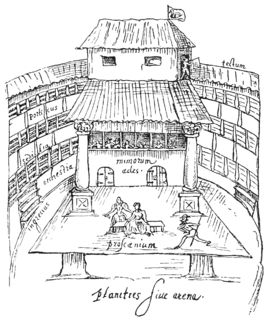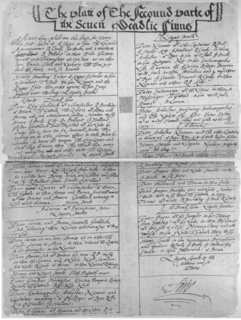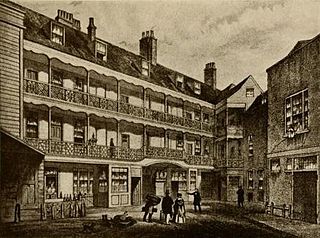
English Renaissance theatre, also known as Renaissance English theatre and Elizabethan theatre, refers to the theatre of England between 1558 and 1642.
The Master of the Revels was the holder of a position within the English, and later the British, royal household, heading the "Revels Office" or "Office of the Revels". The Master of the Revels was an executive officer under the Lord Chamberlain. Originally he was responsible for overseeing royal festivities, known as revels, and he later also became responsible for stage censorship, until this function was transferred to the Lord Chamberlain in 1624. However, Henry Herbert, the deputy Master of the Revels and later the Master, continued to perform the function on behalf of the Lord Chamberlain until the English Civil War in 1642, when stage plays were prohibited. The office continued almost until the end of the 18th century, although with rather reduced status.
The King's Men is the acting company to which William Shakespeare (1564–1616) belonged for most of his career. Formerly known as the Lord Chamberlain's Men during the reign of Queen Elizabeth I, they became the King's Men in 1603 when King James I ascended the throne and became the company's patron.
The Lord Chamberlain's Men was a company of actors, or a "playing company", for which Shakespeare wrote during most of his career. Richard Burbage played most of the lead roles, including Hamlet, Othello, King Lear, and Macbeth. Formed at the end of a period of flux in the theatrical world of London, it had become, by 1603, one of the two leading companies of the city and was subsequently patronized by James I.
In Renaissance-era London, playing company was the usual term for a company of actors. These companies were organized around a group of ten or so shareholders, who performed in the plays but were also responsible for management. The sharers employed "hired men" – that is, the minor actors and the workers behind the scenes. The major companies were based at specific theatres in London; the most successful of them, William Shakespeare's company the King's Men, had the open-air Globe Theatre for summer seasons and the enclosed Blackfriars Theatre in the winters. The Admiral's Men occupied the Rose Theatre in the 1590s, and the Fortune Theatre in the early 17th century.
Queen Anne's Men was a playing company, or troupe of actors, in Jacobean era London. In their own era they were known colloquially as the Queen's Men — as were Queen Elizabeth's Men and Queen Henrietta's Men, in theirs.
The Admiral's Men was a playing company or troupe of actors in the Elizabethan and Stuart eras. It is generally considered the second most important acting troupe of English Renaissance theatre.
Christopher Beeston was a successful actor and a powerful theatrical impresario in early 17th century London. He was associated with a number of playwrights, particularly Thomas Heywood.
Lord Strange's Men was an Elizabethan playing company, comprising retainers of the household of Ferdinando Stanley, Lord Strange. They are best known in their final phase of activity in the late 1580s and early 1590s. After 25 September 1593, they were known as the Earl of Derby's Men, that being the date of Stanley's accession to his father's title.
The Earl of Worcester's Men was an acting company in Renaissance England. An early formation of the company, wearing the livery of William Somerset, 3rd Earl of Worcester, is among the companies known to have toured the country in the mid-sixteenth century. A later iteration of the company toured through the 1580s and '90s; little is known about its activities, though in 1583 it included the sixteen-year-old Edward Alleyn, at the start of his illustrious career.
Augustine Phillips was an Elizabethan actor who performed in troupes with Edward Alleyn and William Shakespeare. He was one of the first generation of English actors to achieve wealth and a degree of social status by means of his trade.
Prince Charles's Men was a playing company or troupe of actors in Jacobean and Caroline England.
Francis Langley (1548–1602) was a theatre builder and theatrical producer in Elizabethan era London. After James Burbage and Philip Henslowe, Langley was the third significant entrepreneurial figure active at the height of the development of English Renaissance theatre.
The Earl of Leicester's Men was a playing company or troupe of actors in English Renaissance theatre, active mainly in the 1570s and 1580s in the reign of Elizabeth I. In many respects, it was the major company in Elizabethan drama of its time, and established the pattern for the companies that would follow: it was the first to be awarded a royal patent, and the first to occupy one of the new public theatres on a permanent basis.

The Seven Deadly Sins was a two-part play written c. 1585, attributed to Richard Tarlton, and most likely premiered by his company, Queen Elizabeth's Men. The play drew upon the medieval tradition of the morality play; though it was very popular in its time, no copy of either part has survived.
The Earl of Sussex's Men was a playing company or troupe of actors in Elizabethan and Jacobean England, most notable for their connection with the early career of William Shakespeare.

In the historical era of English Renaissance drama, an Inn-yard theatre or Inn-theatre was a common inn with an inner courtyard with balconies that provided a venue for the presentation of stage plays.
John Underwood was an early 17th-century actor, a member of the King's Men, the theatrics company of William Shakespeare.
King's Men personnel were the people who worked with and for the Lord Chamberlain's Men and the King's Men from 1594 to 1642. The company was the major theatrical enterprise of its era and featured some of the leading actors of their generation – Richard Burbage, John Lowin, and Joseph Taylor among other – and some leading clowns and comedians, like Will Kempe and Robert Armin. The company benefitted from the services of William Shakespeare, John Fletcher, and Philip Massinger as regular dramatists.
The Earl of Oxford’s Men, alternatively Oxford’s Players, were acting companies in late Medieval and Renaissance England patronised by the Earls of Oxford. The name was also sometimes used to refer to tumblers, musicians, and animal acts that were under the patronage of the Earls or hired by them. The most notable troupe of this name was the acting company of the Elizabethan era patronised by Edward de Vere, the 17th Earl of Oxford (1550-1604), that originally derived from an earlier company, the Earl of Warwick’s Men, and was active from 1580 to 1587. It was revived probably in the late 1590s and ultimately was absorbed by yet another troupe, Worcester's Men, in late 1602.




